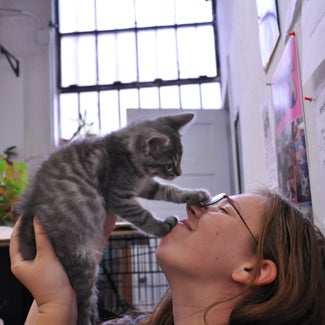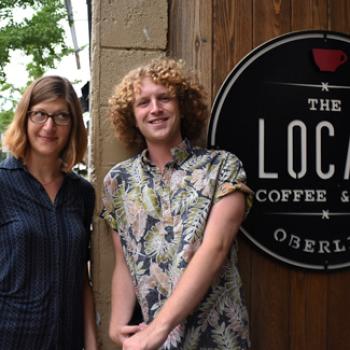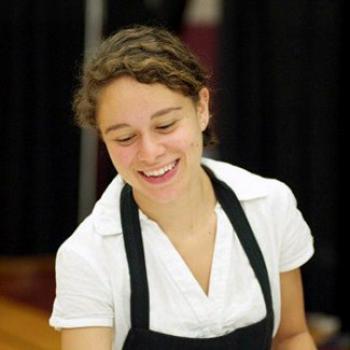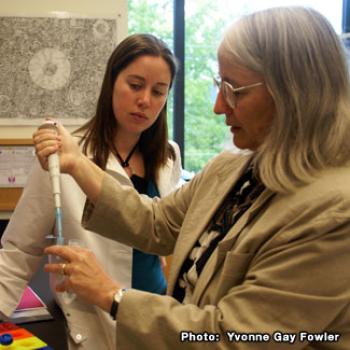On combining love and science
Sierra Zuber ’11
“When I was starting work on my honors biology research with crayfish...I realized how many questions had been right in front of me at Ginko [Gallery] all the time.”

I’ve always loved cats. My family has had cats as pets my whole life, and I invariably prefer bookstores and shops that have resident felines. Naturally, when I came to Oberlin one of my first stops was the Ginko Gallery on Main Street, where, rumor had it, students could pet kittens to their hearts’ content at the back of the store.
I found kittens at Ginko, all right, but I found more, too: CATSS - Community Action To Save Strays, a trap-neuter-return and rescue organization for the stray and feral cats of Oberlin. Ginko is where many of the kittens they rescue grow up to an adoptable age, cared for by Liz, a foster mother specializing in the youngest and most helpless babies. I was determined to help. I quickly parlayed my background in wildlife rehabilitation and my pre-vet student status into a volunteer position.
Over my years at Oberlin, I learned bottle-feeding and de-worming in the back of Ginko and science and lab techniques in classes. I learned to habituate the kittens that were almost too old to tame and to design experiments to probe questions. It wasn’t until the summer before my senior year, when I was starting work on my honors biology research with crayfish, that I realized how many questions had been right in front of me at Ginko all the time. What was Oberlin’s population of strays and ferals like on a genetic level? How much diversity was in the population? Were the Oberlin cats interbreeding with the populations in Elyria or other neighboring towns? Were all those pure-black kittens from one part of town really fathered by that one hulking black tomcat we called Bruiser who refused to be trapped?
But I had my honors research to work on, not to mention all the other amazing things available to an Oberlin senior. Seminar courses, student organizations, ExCos, private readings, and hanging out with friends took all the time I could find. I put my CATSS research idea on the back burner, occasionally talking to Liz or one of my professors. I wasn’t sure anything would come of it, which frustrated me. I wanted to leave Oberlin having given CATSS something besides an extra pair of hands for bottle-feeding, and I wanted to know the answers to my questions.
Well, Oberlin gave me the chance.
The year after I graduated, I lived in Cleveland with two other Obies. I spent the year getting veterinary experience, working with Professor Angela Roles, my honors advisor, on writing up my crayfish research to submit for publication, and getting my CATSS genetics project up and running.
I recruited students, talked to and then joined the CATSS board of directors, and convinced Professor Roger Laushman to sponsor the project and Professor Roles to let me teach a winter term student in her lab. I got the Bonner Center to make an official winter term project for my students and secured a grant for CATSS to fund the research. We started collecting fur samples, working on DNA isolation protocols, and keeping track of feral cats in colonies around Oberlin. One of my students was also trapping for CATSS, and finally caught Bruiser— and she snagged a fur sample when he was on his way to the vet. I made a scorecard for coat colors, the genetics of which are fairly well known in cats, and two of my students recorded the coat colors of dozens of cats. I learned so much from Oberlin professors and administrators and the CATSS board about how to run research and work with institutions.
But alas, science moves slowly sometimes, more slowly than one student’s gap year. When I left Ohio to pursue veterinary school in California, I didn’t know if the project would survive long enough to get the protocols running, collect samples from other populations, or discover just how many kittens Bruiser was responsible for. Nothing happened for many months.
In April, I got an email from Marcelo Vinces, the director of Oberlin’s new Center for Learning, Education and Research in the Sciences (CLEAR). He had heard about my project from CATSS, and wanted to keep it going. I was overjoyed. The project has funding through the grant to CATSS and an overall plan for how the research should proceed, but we need students to work on it. Marcelo hopes to recruit students and use CLEAR’s resources to help keep the project going, and I dearly wish for him to succeed. I want this project to continue on as an opportunity for Oberlin students and a source of information for CATSS. I want to know that something Oberlin gave me the chance to start can become an asset for the college and the cats I’ve come to love.
Tags:
You may also like

On mouthing off in public
“If I hadn’t said it and it hadn’t been heard, I’m not sure I would have met Professor Whelan in the way I did or formed a friendship with her.”
Kepler Mears ’17

On doing research during winter term
“I know of no other school where a professor will welcome a first-year student without a molecular biology background into their lab as willingly as Professor Allen welcomed me.”
Nina Cole ’12

On being a researcher
“I am excited about asking questions, picking apart ideas, and proposing new ways of thinking about problems. I obsess over the details of study designs and execution, all the while striving to be...
Olivia Winter ’08